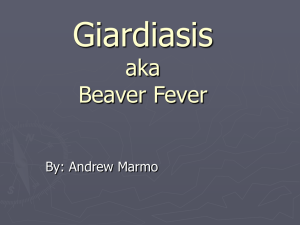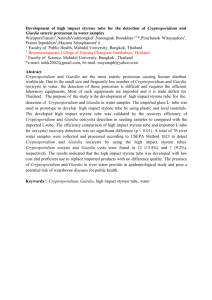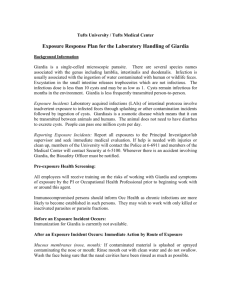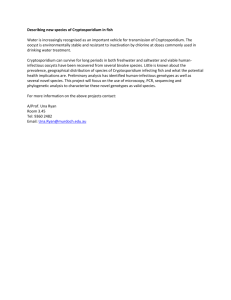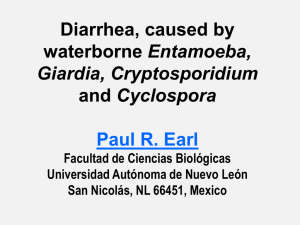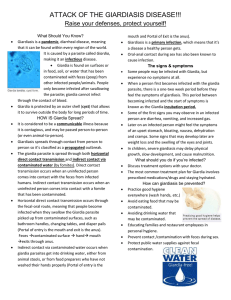Iodine gives water a medicinal taste that some Filtration:
advertisement
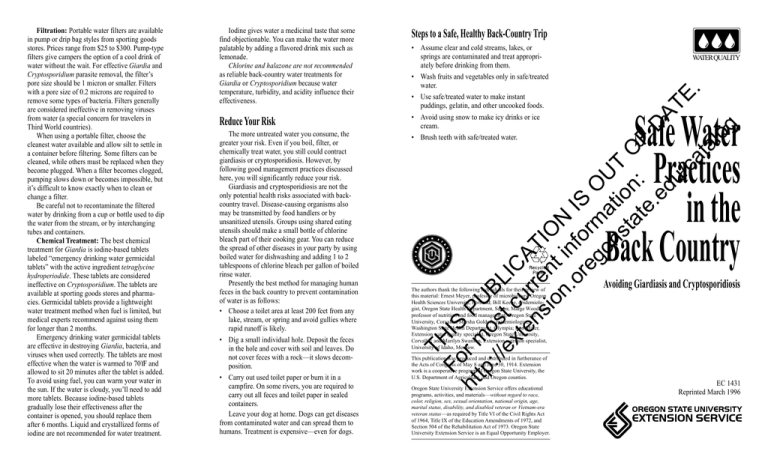
Iodine gives water a medicinal taste that some find objectionable. You can make the water more palatable by adding a flavored drink mix such as lemonade. Chlorine and halazone are not recommended as reliable back-country water treatments for Giardia or Cryptosporidium because water temperature, turbidity, and acidity influence their effectiveness. Reduce Your Risk The more untreated water you consume, the greater your risk. Even if you boil, filter, or chemically treat water, you still could contract giardiasis or cryptosporidiosis. However, by following good management practices discussed here, you will significantly reduce your risk. Giardiasis and cryptosporidiosis are not the only potential health risks associated with backcountry travel. Disease-causing organisms also may be transmitted by food handlers or by unsanitized utensils. Groups using shared eating utensils should make a small bottle of chlorine bleach part of their cooking gear. You can reduce the spread of other diseases in your party by using boiled water for dishwashing and adding 1 to 2 tablespoons of chlorine bleach per gallon of boiled rinse water. Presently the best method for managing human feces in the back country to prevent contamination of water is as follows: • Choose a toilet area at least 200 feet from any lake, stream, or spring and avoid gullies where rapid runoff is likely. • Dig a small individual hole. Deposit the feces in the hole and cover with soil and leaves. Do not cover feces with a rock—it slows decomposition. • Carry out used toilet paper or burn it in a campfire. On some rivers, you are required to carry out all feces and toilet paper in sealed containers. Leave your dog at home. Dogs can get diseases from contaminated water and can spread them to humans. Treatment is expensive—even for dogs. Steps to a Safe, Healthy Back-Country Trip • Assume clear and cold streams, lakes, or springs are contaminated and treat appropriately before drinking from them. • Wash fruits and vegetables only in safe/treated water. • Use safe/treated water to make instant puddings, gelatin, and other uncooked foods. • Avoid using snow to make icy drinks or ice cream. • Brush teeth with safe/treated water. WATER QUALITY TH Fo IS ht r m P U tp o :// s BL ex t c IC te ur A ns re TI io nt ON n. in or fo IS eg rm O on at U st ion T O at : F e. D ed AT u/ E. ca ta lo g Filtration: Portable water filters are available in pump or drip bag styles from sporting goods stores. Prices range from $25 to $300. Pump-type filters give campers the option of a cool drink of water without the wait. For effective Giardia and Cryptosporidium parasite removal, the filter’s pore size should be 1 micron or smaller. Filters with a pore size of 0.2 microns are required to remove some types of bacteria. Filters generally are considered ineffective in removing viruses from water (a special concern for travelers in Third World countries). When using a portable filter, choose the cleanest water available and allow silt to settle in a container before filtering. Some filters can be cleaned, while others must be replaced when they become plugged. When a filter becomes clogged, pumping slows down or becomes impossible, but it’s difficult to know exactly when to clean or change a filter. Be careful not to recontaminate the filtered water by drinking from a cup or bottle used to dip the water from the stream, or by interchanging tubes and containers. Chemical Treatment: The best chemical treatment for Giardia is iodine-based tablets labeled “emergency drinking water germicidal tablets” with the active ingredient tetraglycine hydroperiodide. These tablets are considered ineffective on Cryptosporidium. The tablets are available at sporting goods stores and pharmacies. Germicidal tablets provide a lightweight water treatment method when fuel is limited, but medical experts recommend against using them for longer than 2 months. Emergency drinking water germicidal tablets are effective in destroying Giardia, bacteria, and viruses when used correctly. The tablets are most effective when the water is warmed to 70°F and allowed to sit 20 minutes after the tablet is added. To avoid using fuel, you can warm your water in the sun. If the water is cloudy, you’ll need to add more tablets. Because iodine-based tablets gradually lose their effectiveness after the container is opened, you should replace them after 6 months. Liquid and crystallized forms of iodine are not recommended for water treatment. The authors thank the following individuals for their review of this material: Ernest Meyer, professor of microbiology, Oregon Health Sciences University, Portland; Bill Keene, epidemiologist, Oregon State Health Department, Salem; Marge Woodburn, professor of nutrition and food management, Oregon State University, Corvallis; Marsha Goldoft, epidemiologist, Washington State Health Department, Olympia; Ron Miner, Extension water quality specialist, Oregon State University, Corvallis; and Marilyn Swanson, Extension nutrition specialist, University of Idaho, Moscow. Safe Water Practices in the Back Country Avoiding Giardiasis and Cryptosporidiosis This publication was produced and distributed in furtherance of the Acts of Congress of May 8 and June 30, 1914. Extension work is a cooperative program of Oregon State University, the U.S. Department of Agriculture, and Oregon counties. Oregon State University Extension Service offers educational programs, activities, and materials—without regard to race, color, religion, sex, sexual orientation, national origin, age, marital status, disability, and disabled veteran or Vietnam-era veteran status—as required by Title VI of the Civil Rights Act of 1964, Title IX of the Education Amendments of 1972, and Section 504 of the Rehabilitation Act of 1973. Oregon State University Extension Service is an Equal Opportunity Employer. EC 1431 Reprinted March 1996 Safe Water Practices in the Back Country— Avoiding Giardiasis and Cryptosporidiosis H. Conner and M.A. Sward In the back country, you are at risk if you drink untreated water from any source—streams, rivers, lakes, and even springs. But back-country water users are not alone; others at risk include: • People who accidentally ingest nonpurified water when swimming or irrigating. • People whose home drinking water comes from unchlorinated and unfiltered surface water, springs, or shallow wells. • Infants and children, especially those in day care facilities, and the people who care for them (risk of fecal-oral contamination) • People whose sexual practices involve fecal-oral contact. • Travelers in foreign countries, especially countries with poor sanitation or untreated surface water. TH Fo IS ht r m P U tp o :// s BL ex t c IC te ur A ns re TI io nt ON n. in or fo IS eg rm O on at U st ion T O at : F e. D ed AT u/ E. ca ta lo g Even though Northwest streams, rivers, lakes, and springs are famous for their natural beauty and clear, sparkling water, all back-country water should be considered contaminated by Giardia (jee-ar-dee-uh) or other potentially harmful microorganisms. Drinking straight from these water sources invites disease. Giardia is a leading cause of waterborne infectious diarrhea, not only in the United States but in nearly every country in the world. Another concern for users of backcountry water is Cryptosporidium, which also causes diarrheal illness. Who’s at Risk? What is Giardia? This microscopic, protozoan parasite can cause health problems in humans and in some animals, including dogs. Giardia cysts enter the host by mouth, usually by ingesting water or food contaminated with feces. While in the body, Giardia multiplies in the intestine and can cause the disease giardiasis. Microscopic cysts of the Giardia parasite are shed in the feces of infected people and animals. The cysts may survive for months in water or snow. • People who are in close contact with infected calves, lambs, or other animals (risk of infection from Cryptosporidium, primarily). What is Cryptosporidium? Origin of Giardia and Cryptosporidium Cryptosporidium is another protozoan parasite that also can infect and cause disease in a wide variety of mammals. Oocysts (egg capsules) are shed in the feces of infected animals and people, and can contaminate water. Several outbreaks have been linked to improperly treated city water of surface origin. Since cryptosporidiosis is not a reportable disease in Oregon, little is known about the number of cases affecting people using backcountry areas. Some animals, such as beavers and muskrats, carry Giardia and can contaminate the water with their feces. Cryptosporidium is closely linked to contamination of water by cattle feces or human sewage. Studies have shown that both organisms are widespread in surface water in the United States. Increased human use of back-country areas may have added to the problem. Both human and animal feces containing Giardia or Cryptosporidium parasites can be carried into streams, lakes, springs, and even shallow wells with runoff. Helen Conner, former Extension agent, Malheur County; and Mary Ann Sward, Extension housing specialist; Oregon State University. Giardiasis and Cryptosporidiosis— The Diseases The symptoms of giardiasis show up 5 to 25 days after the contaminated water or cysts are consumed. Symptoms of cryptosporidiosis begin in an average of 7 days. The most common symptoms of both diseases are persisting diarrhea and an unpleasant, bloated feeling. Because Giardia interfere with the absorption of fat, the stools often will be foul smelling and look pale and greasy. If you have these symptoms, seek medical advice for positive identification of the disease and treatment. Giardiasis can be treated with several different drugs. Although cryptosporidiosis is more difficult to identify, the disease usually is self limiting and is gone within 1 or 2 weeks. Both diseases can be quite unpleasant but usually are not life threatening. The exception is cryptosporidiosis in those who are immunosuppressed (for example, AIDS patients). Since there is no known therapy, the disease can be life threatening in these patients. Many people infected with Giardia or Cryptosporidium have no symptoms, but may shed cysts and infect others. Those with cryptosporidiosis appear to develop antibodies and some immunity to the disease for an unknown length of time. Preventing Giardiasis and Cryptosporidiosis If you are going into the back country, or to a country with poor sanitation, treat all water you consume as if it’s contaminated with Giardia or Cryptosporidium. The best treatment method is to boil the water. Filtering and some forms of chemical treatment also can be effective in reducing the risk. Good hand washing and sanitation practices also are important when camping. Today, most public water supplies are treated, and all are required to test for and treat for Giardia if present. Most are not required to test for Cryptosporidium. When Giardia or Cryptosporidium is a concern in home water supplies originating from surface water, springs, or shallow wells, the home treatment system must be selected carefully and maintained properly. Avoid Spreading Giardia Cysts Some people get the parasites that cause giardiasis or cryptosporidiosis from others. To avoid spreading disease, wash your hands thoroughly after caring for a sick person, after changing baby’s diapers, after working or playing with animals, after going to the bathroom, and before handling food. Treating Back-Country Water: What Works Best Protection Rolling boil for 1 minute Filter water with portable filter with 1 micron or smaller pore size. Treat water with drinking water germicidal tablets (not effective on Cryptosporidium) Poorest Protection Chlorine or halazone tablets added to water. How to Treat the Water Boiling: Giardia cysts are killed at about 135°F, which is considerably lower than boiling temperature. However, it’s difficult for campers to know when water has reached that temperature, particularly at higher elevations. To ensure safe water, bring the water to a full rolling boil and boil for 1 minute. This will destroy Giardia and Cryptosporidium parasites and also bacteria that may contaminate water in any of the Northwest states. You also should boil foods with added water for at least 1 minute. H. Conner and M.A. Sward Even though Northwest streams, rivers, lakes, and springs are famous for their natural beauty and clear, sparkling water, all back-country water should be considered contaminated by Giardia (jee-ar-dee-uh) or other potentially harmful microorganisms. Drinking straight from these water sources invites disease. Giardia is a leading cause of waterborne infectious diarrhea, not only in the United States but in nearly every country in the world. Another concern for users of backcountry water is Cryptosporidium, which also causes diarrheal illness. What is Giardia? This microscopic, protozoan parasite can cause health problems in humans and in some animals, including dogs. Giardia cysts enter the host by mouth, usually by ingesting water or food contaminated with feces. While in the body, Giardia multiplies in the intestine and can cause the disease giardiasis. Microscopic cysts of the Giardia parasite are shed in the feces of infected people and animals. The cysts may survive for months in water or snow. Who’s at Risk? In the back country, you are at risk if you drink untreated water from any source—streams, rivers, lakes, and even springs. But back-country water users are not alone; others at risk include: • People who accidentally ingest nonpurified water when swimming or irrigating. • People whose home drinking water comes from unchlorinated and unfiltered surface water, springs, or shallow wells. • Infants and children, especially those in day care facilities, and the people who care for them (risk of fecal-oral contamination) • People whose sexual practices involve fecal-oral contact. • Travelers in foreign countries, especially countries with poor sanitation or untreated surface water. • People who are in close contact with infected calves, lambs, or other animals (risk of infection from Cryptosporidium, primarily). What is Cryptosporidium? Origin of Giardia and Cryptosporidium Cryptosporidium is another protozoan parasite that also can infect and cause disease in a wide variety of mammals. Oocysts (egg capsules) are shed in the feces of infected animals and people, and can contaminate water. Several outbreaks have been linked to improperly treated city water of surface origin. Since cryptosporidiosis is not a reportable disease in Oregon, little is known about the number of cases affecting people using backcountry areas. Some animals, such as beavers and muskrats, carry Giardia and can contaminate the water with their feces. Cryptosporidium is closely linked to contamination of water by cattle feces or human sewage. Studies have shown that both organisms are widespread in surface water in the United States. Increased human use of back-country areas may have added to the problem. Both human and animal feces containing Giardia or Cryptosporidium parasites can be carried into streams, lakes, springs, and even shallow wells with runoff. Helen Conner, former Extension agent, Malheur County; and Mary Ann Sward, Extension housing specialist; Oregon State University. Giardiasis and Cryptosporidiosis— The Diseases The symptoms of giardiasis show up 5 to 25 days after the contaminated water or cysts are consumed. Symptoms of cryptosporidiosis begin in an average of 7 days. The most common symptoms of both diseases are persisting diarrhea and an unpleasant, bloated feeling. Because Giardia interfere with the absorption of fat, the stools often will be foul smelling and look pale and greasy. If you have these symptoms, seek medical advice for positive identification of the disease and treatment. Giardiasis can be treated with several different drugs. Although cryptosporidiosis is more difficult to identify, the disease usually is self limiting and is gone within 1 or 2 weeks. Both diseases can be quite unpleasant but usually are not life threatening. The exception is cryptosporidiosis in those who are immunosuppressed (for example, AIDS patients). Since there is no known therapy, the disease can be life threatening in these patients. Many people infected with Giardia or Cryptosporidium have no symptoms, but may shed cysts and infect others. Those with cryptosporidiosis appear to develop antibodies and some immunity to the disease for an unknown length of time. When Giardia or Cryptosporidium is a concern in home water supplies originating from surface water, springs, or shallow wells, the home treatment system must be selected carefully and maintained properly. Avoid Spreading Giardia Cysts TH Fo IS ht r m P U tp o :// s BL ex t c IC te ur A ns re TI io nt ON n. in or fo IS eg rm O on at U st ion T O at : F e. D ed AT u/ E. ca ta lo g Safe Water Practices in the Back Country— Avoiding Giardiasis and Cryptosporidiosis Preventing Giardiasis and Cryptosporidiosis If you are going into the back country, or to a country with poor sanitation, treat all water you consume as if it’s contaminated with Giardia or Cryptosporidium. The best treatment method is to boil the water. Filtering and some forms of chemical treatment also can be effective in reducing the risk. Good hand washing and sanitation practices also are important when camping. Today, most public water supplies are treated, and all are required to test for and treat for Giardia if present. Most are not required to test for Cryptosporidium. Some people get the parasites that cause giardiasis or cryptosporidiosis from others. To avoid spreading disease, wash your hands thoroughly after caring for a sick person, after changing baby’s diapers, after working or playing with animals, after going to the bathroom, and before handling food. Treating Back-Country Water: What Works Best Protection Rolling boil for 1 minute Filter water with portable filter with 1 micron or smaller pore size. Treat water with drinking water germicidal tablets (not effective on Cryptosporidium) Poorest Protection Chlorine or halazone tablets added to water. How to Treat the Water Boiling: Giardia cysts are killed at about 135°F, which is considerably lower than boiling temperature. However, it’s difficult for campers to know when water has reached that temperature, particularly at higher elevations. To ensure safe water, bring the water to a full rolling boil and boil for 1 minute. This will destroy Giardia and Cryptosporidium parasites and also bacteria that may contaminate water in any of the Northwest states. You also should boil foods with added water for at least 1 minute. Iodine gives water a medicinal taste that some find objectionable. You can make the water more palatable by adding a flavored drink mix such as lemonade. Chlorine and halazone are not recommended as reliable back-country water treatments for Giardia or Cryptosporidium because water temperature, turbidity, and acidity influence their effectiveness. TH Fo IS ht r m P U tp o :// s BL ex t c IC te ur A ns re TI io nt ON n. in or fo IS eg rm O on at U st ion T O at : F e. D ed AT u/ E. ca ta lo g Filtration: Portable water filters are available in pump or drip bag styles from sporting goods stores. Prices range from $25 to $300. Pump-type filters give campers the option of a cool drink of water without the wait. For effective Giardia and Cryptosporidium parasite removal, the filter’s pore size should be 1 micron or smaller. Filters with a pore size of 0.2 microns are required to remove some types of bacteria. Filters generally are considered ineffective in removing viruses from water (a special concern for travelers in Third World countries). When using a portable filter, choose the cleanest water available and allow silt to settle in a container before filtering. Some filters can be cleaned, while others must be replaced when they become plugged. When a filter becomes clogged, pumping slows down or becomes impossible, but it’s difficult to know exactly when to clean or change a filter. Be careful not to recontaminate the filtered water by drinking from a cup or bottle used to dip the water from the stream, or by interchanging tubes and containers. Chemical Treatment: The best chemical treatment for Giardia is iodine-based tablets labeled “emergency drinking water germicidal tablets” with the active ingredient tetraglycine hydroperiodide. These tablets are considered ineffective on Cryptosporidium. The tablets are available at sporting goods stores and pharmacies. Germicidal tablets provide a lightweight water treatment method when fuel is limited, but medical experts recommend against using them for longer than 2 months. Emergency drinking water germicidal tablets are effective in destroying Giardia, bacteria, and viruses when used correctly. The tablets are most effective when the water is warmed to 70°F and allowed to sit 20 minutes after the tablet is added. To avoid using fuel, you can warm your water in the sun. If the water is cloudy, you’ll need to add more tablets. Because iodine-based tablets gradually lose their effectiveness after the container is opened, you should replace them after 6 months. Liquid and crystallized forms of iodine are not recommended for water treatment. Reduce Your Risk The more untreated water you consume, the greater your risk. Even if you boil, filter, or chemically treat water, you still could contract giardiasis or cryptosporidiosis. However, by following good management practices discussed here, you will significantly reduce your risk. Giardiasis and cryptosporidiosis are not the only potential health risks associated with backcountry travel. Disease-causing organisms also may be transmitted by food handlers or by unsanitized utensils. Groups using shared eating utensils should make a small bottle of chlorine bleach part of their cooking gear. You can reduce the spread of other diseases in your party by using boiled water for dishwashing and adding 1 to 2 tablespoons of chlorine bleach per gallon of boiled rinse water. Presently the best method for managing human feces in the back country to prevent contamination of water is as follows: • Choose a toilet area at least 200 feet from any lake, stream, or spring and avoid gullies where rapid runoff is likely. • Dig a small individual hole. Deposit the feces in the hole and cover with soil and leaves. Do not cover feces with a rock—it slows decomposition. • Carry out used toilet paper or burn it in a campfire. On some rivers, you are required to carry out all feces and toilet paper in sealed containers. Leave your dog at home. Dogs can get diseases from contaminated water and can spread them to humans. Treatment is expensive—even for dogs. Steps to a Safe, Healthy Back-Country Trip • Assume clear and cold streams, lakes, or springs are contaminated and treat appropriately before drinking from them. • Wash fruits and vegetables only in safe/treated water. • Use safe/treated water to make instant puddings, gelatin, and other uncooked foods. • Avoid using snow to make icy drinks or ice cream. • Brush teeth with safe/treated water. The authors thank the following individuals for their review of this material: Ernest Meyer, professor of microbiology, Oregon Health Sciences University, Portland; Bill Keene, epidemiologist, Oregon State Health Department, Salem; Marge Woodburn, professor of nutrition and food management, Oregon State University, Corvallis; Marsha Goldoft, epidemiologist, Washington State Health Department, Olympia; Ron Miner, Extension water quality specialist, Oregon State University, Corvallis; and Marilyn Swanson, Extension nutrition specialist, University of Idaho, Moscow. WATER QUALITY Safe Water Practices in the Back Country Avoiding Giardiasis and Cryptosporidiosis This publication was produced and distributed in furtherance of the Acts of Congress of May 8 and June 30, 1914. Extension work is a cooperative program of Oregon State University, the U.S. Department of Agriculture, and Oregon counties. Oregon State University Extension Service offers educational programs, activities, and materials—without regard to race, color, religion, sex, sexual orientation, national origin, age, marital status, disability, and disabled veteran or Vietnam-era veteran status—as required by Title VI of the Civil Rights Act of 1964, Title IX of the Education Amendments of 1972, and Section 504 of the Rehabilitation Act of 1973. Oregon State University Extension Service is an Equal Opportunity Employer. EC 1431 Reprinted March 1996
